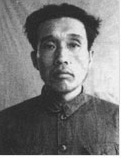據住岡義一1955年5月筆供,他1917年出生在日本大阪市,1939年入伍并于同月侵入中國安徽宣城縣。1945年8月日軍投降后投靠國民黨閻錫山部。1948年7月10日在山西太原被俘。

住岡義一
重要罪行有:
1940年1月,在安徽宣城新兵訓練中,“把新四軍和抗日軍的俘虜約10名,當作"教育材料"刺殺了”。
1940年2月,在作戰休息時,將“從民房中逃出來的1名老人,我先用刺刀刺其背部”,“該老人口吐鮮血死去”。
1941年12月,在山西太原,逮捕村民兩人,“用日本刀刺第1名的胸部殺死”。對另1名同樣“命部下將其斬殺”。
1942年2月中旬,在太谷縣新莊村后山的山洞中捉來村民4名,“我將其中二十二三歲的婦女在我的房中將其強奸了,另外的約27歲的婦女,由部下二三名輪奸”。對兩名男人因拷問不回答,將其1名殺害。
同在2月中旬,在摩天嶺東南某村,“襲擊轉移中的八路軍醫院,在民房中逮捕病員5名”,對其中兩名拷打后,“我親自用日本刀將其斬殺”。
1942年2月下旬,“掩護大隊本部醫務室曾根軍醫大尉以下約10名,撒布傷寒菌和霍亂菌”。“此間我的小隊與中隊一齊,在和順縣龍門村、官池堂、陽樂莊其他二三個村莊(村名不詳)占領要點,對醫務室的人員在民房中,向碗、筷、菜刀、面杖、面板、桌子等食器類上涂抹細菌,又向盛飲水用的水缸中投細菌,或向村中的井中及附近的河中投入細菌的行動進行掩護”。
1942年3月下旬,“把拘留著的八路軍女工作員(25歲左右)強奸后又由縣警備隊的士兵輪奸”。中隊長為了不讓大隊長知道,“命我將上述的婦女及拘留著的八路軍工作員2名、大盂鎮的商人1名共4名殺害之”。
1942年5月下旬,在將軍墓村西頭民房中,將前一天在戰斗中俘虜的八路軍作戰員及干部5名,“我親自用日本刀斬殺”。
1942年6月,在彰德縣水冶鎮大街宿營,“我將一家中20歲左右的姑娘強奸了,此后又叫部下強奸了其母親”。
1942年7月,在太原市侯家巷駐扎期間,“實施刺殺活肉靶檢閱時,……帶來的俘虜(大部分是八路軍的戰士、干部、學生,一部分是抗日軍的戰士)約220名,每人刺殺1名”。“現兵役教育方針是:……要以活著的中國人作教育材料,進行試膽、鍛煉為方針。……各教官(包括我在內)根據此進行準備教育后,……把檢閱課目中的刺殺假設敵改變為刺殺活肉靶”。
1942年8月2日前后,“指揮機關槍新兵約70名,把……俘虜約70名(其中有約50名是婦女),當作教育材料將其刺殺”。“于此次檢閱期間,各教官、助教及約340名新兵,共殺害了約340名俘虜”。
1943年6月下旬,“指示中隊附田中少尉把以八路軍的嫌疑拘留在中隊拘留所的村民1名,在該村外南側小溝內用日本刀斬殺”。
1944年8月下旬,在沁縣,“暖柳村及小河村逮捕村民各1名”,“我命馬隊長將上述2名在沁縣城西側河灘射殺”。
According to the written confession of Giichi Sumioka in May 1955, he was born in Osaka, Japan in 1917. In 1939, he joined the army and invaded Xuancheng County, Anhui Province, China in the same month. After Japan's surrender in August 1945, he took refuge in Yan Xishan's troops. He was arrested on 10 July 1948 in Taiyuan, Shanxi.
Confessions of Japanese war criminal Giichi Sumioka
Major offences:
January 1940: while training the new recruits in Xuancheng, Anhui, "stabbed to death about 10 captives from the New Fourth Army and the anti-Japanese army as 'educational materials'";
February 1940: while taking a break between battles, "I stabbed on the back of an old man who was running away from a civilian house", and "the old man spit out blood and died";
December 1941: in Taiyuan, Shanxi, arrested two villagers, "stabbed with a Japanese sword on the chest of one of them and killed him" and "ordered my subordinates to kill" the other one;
Mid-February 1942: captured four villagers in a cave on the back hills of Xinzhuang Village, Taigu County, "I raped a woman aged 22 or 23 among them in my room, and another 27-year-old woman was gang-raped by two or three of my subordinates". The two men were interrogated with torture and said nothing, so one of them was killed;
Mid-February 1942: in a village to the southeast of Motianling, "assaulted a hospital of the Eighth Route Army on its way of evacuating; arrested 5 patients in a civilian house", after interrogating with torture two of them, "I killed them with a Japanese sword by myself";
Late February 1942: "covered up for about 10 surgeon senior captains from the Headquarters Dispensary of the Battalion to spread typhoid and cholera bacteria", "in the process, my Platoon worked together with the Company, occupying vantage points in Longmen Village, Guanchitang, Yanglezhuang and another two or three villages (names not clear) in Heshun County, wher we covered the medical staff as they smeared bacteria on bowls, chopsticks, kitchen knives, rolling pins, cutting boards and tables in villagers' houses and threw bacteria into their water vats, wells and rivers nearby";
Late March 1942: "raped a female operator (aged around 25) of the Eighth Route Army, who was in custody, and then let the County Police gang rape her". In order to keep it secret from the Battalion Chief, the Company Commander "ordered me to kill the above-mentioned woman and two other captured operators of the Eighth Route Army and a businessman from Dayu Township, a total of 4 people";
Late May 1942: in a civilian house in the west of Jiangjunmu Village, "I personally killed with Japanese sword" 5 soldiers and cadres of the Eighth Route Army, who had been captured in the battle the day before;
June 1942: while camping in the streets of Shuizhi Township, Zhangde County, "I raped a 20-year-old girl in her home and ordered my subordinates to rape her mother";
July 1942: when stationing in Houjiaxiang, Taiyuan City, "when we conducted an inspection on bayoneting living targets … about 220 captives (mostly soldiers and cadres of the Eighth Route Army, students, and some soldiers of the anti-Japanese army) were brought here, one for each Japanese soldier to kill". "The active service education policy was: … to use live Chinese people as educational materials to test Japanese soldiers' courage and train them … all the instructors (including myself) prepared accordingly …… change the imaginary enemy into live targets in the stabbing course for inspection";
Around 2 August 1942: "ordered 70 new recruits of the machine gun units to … stab 70 captives (about 50 of them were women) as educational materials"; "during this inspection, all instructors, teaching assistants and about 340 new recruits killed a total of about 340 captives" ;
Late June 1943: "ordered Second Lieutenant Tanaka to kill with Japanese sword one villager, who was detained in the Company as an Eighth Route Army soldier suspect, in a little trench to the south of the village";
Late August 1944: in Qinxian County, "we captured one villager each from Nuanliu Village and Xiaohe Village"; "I ordered Captain Ma to shoot these two captives to death on the riverside to the west of Qinxian County".
(來源:國家檔案局網站,編輯 Helen)